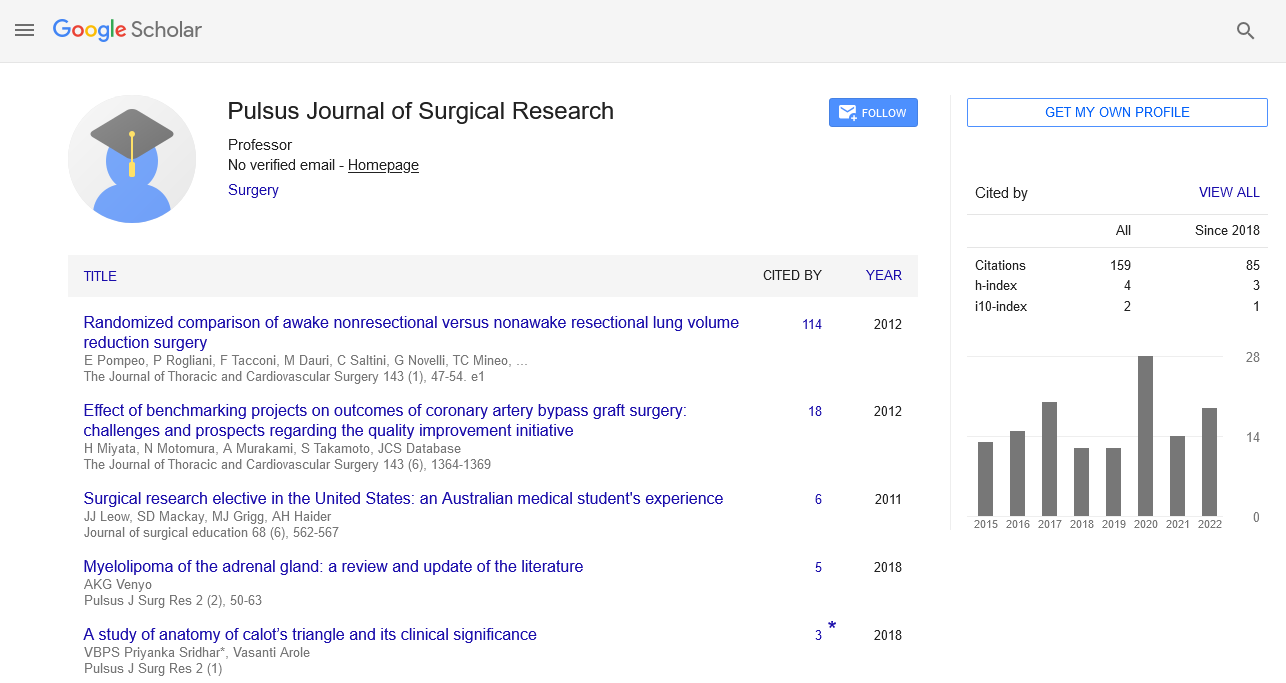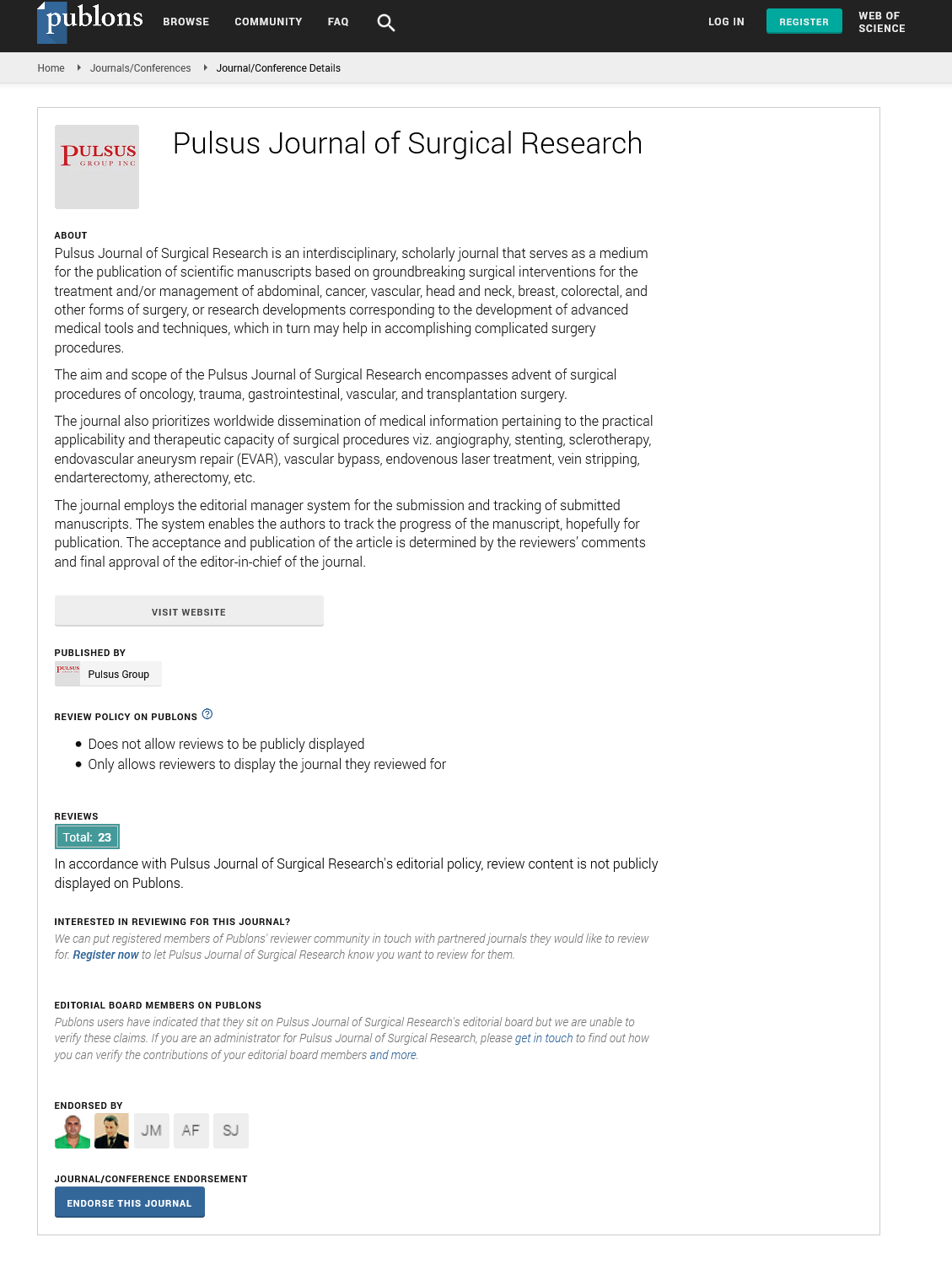The possibility of virus transmission during minimally invasive surgery
Received: 03-Dec-2022, Manuscript No. pulpjsr- 22-5820; Editor assigned: 06-Dec-2022, Pre QC No. pulpjsr- 22-5820 (PQ); Accepted Date: Dec 26, 2022; Reviewed: 18-Dec-2022 QC No. pulpjsr- 22-5820 (Q); Revised: 24-Dec-2022, Manuscript No. pulpjsr- 22-5820 (R); Published: 30-Dec-2022
Citation: Sofi A . The possibility of virus transmission during minimally invasive surgery. J surg Res. 2022; 6(6):79-81.
This open-access article is distributed under the terms of the Creative Commons Attribution Non-Commercial License (CC BY-NC) (http://creativecommons.org/licenses/by-nc/4.0/), which permits reuse, distribution and reproduction of the article, provided that the original work is properly cited and the reuse is restricted to noncommercial purposes. For commercial reuse, contact reprints@pulsus.com
Abstract
The surgical smoke that accumulated during various laparoscopic procedures (colorectal resections, gastrostomies, and hepatic wedge resections). Other clinical trials pointed to a consistent risk of human papillomavirus (HPV) transmission after surgical procedures for HPV-related diseases (mainly genital warts, laryngeal papillomas, or cutaneous lesions). Although preclinical research produced mixed results, HPV was found to have a significant probability of transmission. Although all the information is derived from several viruses and the virus has been detected in faces and blood, the potential risk of virus diffusion by surgical smoke cannot be completely ruled out. To comprehend the precise existence of the virus and its concentration in the surgical smoke of various surgical operations, specific clinical studies are required.
Keywords
Surgical care; Virtual reality; Neuro surgery; Endocrine.
Introduction
THe severe acute respiratory syndrome coronavirus and the T sickness it causes, coronavirus disease, are quickly and tragically escalating a global health crisis. The necessity to devote large medical resources to the care of critically ill COVID-19 patients is transforming the health systems in many countries. This has important ramifications for medical disciplines that are not primarily involved in the management of COVID-19 patients as well. According to particular guidelines for patient triage from international societies and independent research groups, the bulk of the centers in the regions more severely affected by the pandemic are restricting their surgical activity. Recommendations for laparotomy and laparoscopic surgery to reduce the danger of viruses being dispersed in aerosols have recently been published. In particular, surgical smoke was thought to carry a risk of containing a live virus, and laparoscopic surgery was thought to raise the risk of infection due to the greater surgical smoke particle concentration and the possibility of aerosol dissemination from pneumoperitoneum leaking. Therefore, the authors advised paying close attention, reducing the use of electrocautery, decreasing pneumoperitoneum pressure, and using a lot of suction devices to remove smoke and aerosol during operations, particularly before switching from laparoscopy to open surgery or performing any extra peritoneal maneuver. Several worldwide surgical organizations advised caution or even prohibited the use of a laparoscopic method during the pandemic, despite the fact that, to our knowledge, no cases of CoV-2 contagion attributable to those mechanisms have been recorded during surgical procedures.
The possible risk of surgical smoke has largely gone unaddressed in surgery over the past few decades.
As a result, we made the decision to conduct a thorough review of the literature assessing the risk of virus transmission due to surgical smoke for healthcare professionals during surgical procedures (of any surgical specialties and for any clinical indications) performed on patients with a viral disease. Additionally, we made the decision to compile all experimental research in which surgical smoke in identical clinical settings was tested for the existence of any virus remains and/or its capacity to transmit virus contagion. Patients who underwent a range of robotic and laparoscopic surgeries (including colorectal resections in five cases, gastrostomies in three cases, and hepatic wedge resections in another three cases), among other surgeries. All of these patients had positive hepatitis B surface antigens (HBsAg) prior to surgery. Additionally, two of the patients had detectable hepatitis B surface antibody (HBsAb), two had positive hepatitis B e antigen, and three patients were currently using antihepatitis B viral medicines. Hepatitis B virus (HBV) DNA was searched for in the surgical smoke created during the various laparoscopies. The patients' HBV DNA could be identified thanks to the polymerase chain reaction. The majority of the available evidence indicated a potential risk of transmission, and all other clinical research concentrated on human papillomavirus (HPV) infection. Gloster and Roenigk specifically reported on a survey of laser surgeons. They were contrasted with the patients seen in two population-based cohorts (patients with warts in Olmsted County and at the Mayo Clinic from 1988 to 1992) in terms of the prevalence and localization of their lesions. Overall, the risk for warts among surgeons was comparable to that of the general population. However, there was a considerably higher rate of nasopharyngeal localization in laser surgeons, indicating a particular risk for the upper airway mucosa from the laser plume. The CO2 laser was used by laser surgeons to treat verrucae. Hand lesions were the most common type of HPV-related lesion, with dermatologists reporting the highest incidence. The vast majority of the other studies evaluating the presence of HPV in surgical smoke found HPV in the majority of dermatology and gynecological reports. The virus in surgical byproducts could not be detected in only three minor trials. Furthermore, two further studies found HPV DNA on samples taken from the surgeons' nasolabial fold, noses, and conjunctiva as well as on the surgical gloves after laser ablation of laryngeal papilloma’s and genital warts. Again, with inconsistent outcomes, the majority of preclinical investigations focused on HPVs and bovine papillomaviruses. In particular, some research analyzing the presence of viral DNA in the surgical smoke following laser treatments of infected cell cultures reconfirmed the virus's presence, whilst other investigations were unable to replicate similar findings. However, the remarkable transmissibility of the mouse papillomavirus was recently proven in the most elegant animal model (MmuPV1).
Specifically, knife excision, KTP laser ablation, and coblator therapy were applied to naked laboratory mice with developed MmuPV1 tail warts. Subsequently, surgical waste products, such as heated and abraded tissue, and surgical smoke products, were used to challenge uninfected nude mice. Importantly, the study showed that mice exposed to all of the various surgical byproducts had extremely high levels of infection penetrance (penetrance of infection at day and with byproducts of scalpel treatment, by day with byproducts of KTP laser, and penetrance at day and a maximum of penetrance with bypro- ducts of coblation). Similar to the smoke plume captured after treatment with the KTP laser and coblator, the material trapped in a laser filter was similarly highly contagious. Concerning studies looking into other viruses, cell cultures infected with various viruses, including the human immunodeficiency virus (HIV), pseudorabies virus, varicella-zoster virus, and oral poliovirus, have been treated with various lasers to determine the ability of the byproducts to generate infected positive cultured cells,with the majority of the results showing negative results. Bias potential for both clinical and preclinical investigations. Although almost all of the studies raised some questions about potential biases in a few of the domains of the NTP/OHAT Risk of Bias Rating Tool for Human and Animal Studies, the majority of the clinical and preclinical findings generally had good quality. The COVID-19 pandemic is having a substantial impact on health systems around the world, as well as on medical specialties that aren't primarily involved in the management of COVID-19 patients. In particular, the vast majority of the hospitals in the worst-hit regions are curtailing their surgical operations. Regarding surgery, a recent report highlighted the need to raise awareness among surgeons of the potential risks of virus diffusion due to aerosol dispersal during laparoscopic surgeries, known for several years, and several international surgical societies have urged caution or even discouraged the use of a laparoscopic approach during the pandemic. Based on these worries, we decided to conduct a thorough literature analysis in order to assess the actual risk of virus dissemination through surgical smoke. On this subject, a sizable number of clinical and preclinical research publications have been found. In line with the goal of the present review, the strongest evidence was found in the numerous surgical smoke samples taken during laparoscopic and robotic procedures, where HBV DNA was found. The vast majority of the literature revealed a high risk of infection associated with HPV, and the bulk of the publications analyzed the HPV virus and reladiseasesease. The current work provides the appropriate foundation to evaluate the risk of diffusion of the novel SARS-CoV-2 virus for health professionals, for whom no clinical trial is available, as it used a standardized process to find all the relevant information in the field. The SARS-CoV-2 virus has been detected in blood and feces, thus even though all the data currently available are from viruses very different from the novel coronavirus, the theoretical risk of virus dissemination by surgical smoke cannot be completely ruled out. Adoption of all necessary protective measures seems mandatory, even though specific clinical investigations are needed to determine the virus's concentration and effectiveness in the surgical smoke of various surgical operations. In this regard, all actions (such as reducing the use of electrocautery, lowering the pneumoperitoneum pressure, and using a lot of suction devices to remove smoke and aerosol during operations, especially before switching from laparoscopy to open surgery or performing any extraperitoneal maneuver) can be viewed as appropriate. Additionally, it may be advisable to collect a preoperative nasopharyngeal sample for COVID-19. Despite this, it does not appear that the information is sufficient to advise the complete suspension of all laparoscopic and robot-assisted surgical initiatives. The current study is not without flaws. First off, the majority of the research that was available was actually focused on HPV, a very different type of virus, and we were unable to find any papers that were specifically focused on the new or another coronavirus. This emphasizes the demand for focused research on the subject. Second, just one study examined whether HBV-infected patients' laparoscopic procedures caused any virus to be present in the smoke. The study evaluates the specific type of surgical environment that is currently being discussed. It goes without saying that viruses with drastically different structural characteristics may behave differently in this rega--rd, and the presence of a virus in surgical smoke does not necessarily indicate an airborne infection additionally, it should be remembered that open surgery also produces surgical smoke. Recent reports and laparoscopic surgical procedures in the operating rooms for obstetrics and gynecology at three different hospitals in Taiwan have shown that the total number of particles produced by the laparoscopic procedure was higher than that of the laparotomy performed with an electronic knife. However, open cases had a quantitatively larger total number of particles after utilizing the electronic knife. Despite the fact that none of the reported changes were statistically significant, they nonetheless call for some care in open surgery, where surgical smoke evacuation and filtering need to be more thoroughly researched and used.
Third, even though the current systematic review adhered to a stringent approach, the general caliber of the conclusions is mostly influenced by the caliber of the available evidence. However, a signifi--cant percentage of the reports we evaluated as having high methodological quality using the NTP/OHAT Risk of Bias Rating Tool for Human and Animal Studies. The SARS-CoV-2 virus has been detected in blood and feces, thus even though all the data now available are from viruses very different from the novel coronavirus, the potential risk of virus diffusion by surgical smoke cannot be completely ruled out.
Adoption of all necessary protective techniques, including preoperative patient nasopharyngeal swabs for COVID-19, seems mandatory, even though specific clinical investigations are needed to determine the virus's effective presence in the surgical smoke of various surgical operations and its concentration. The evidence that is now available does not seem to be enough to suggest that all laparoscopic and robot-assisted surgical initiatives should be completely suspended.






